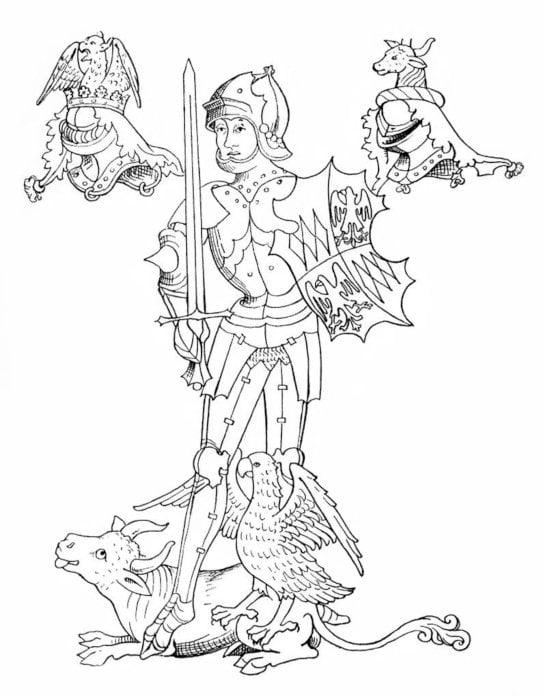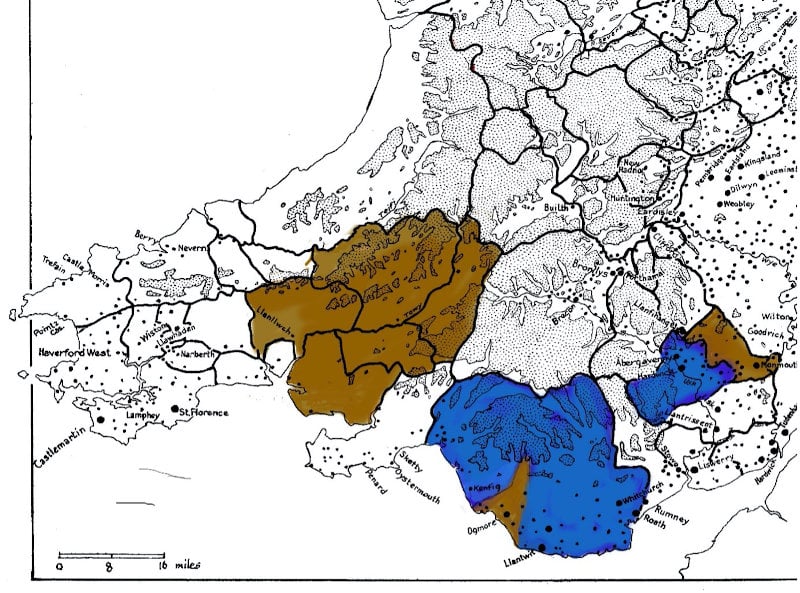
Vortex of Violence – South Wales and the Beginning of the Wars of the Roses
In his seminal work ‘The End of the House of Lancaster’ Professor R. L. Storey places the beginning of the Wars of the Roses firmly in the period July/August 1453 and attributes its origins to the rising tensions between the Neville and Percy families in Yorkshire during that summer. This ignores a far more violent feud between two altogether more powerful cousins, both closely related to the Nevilles, which had raged in south Wales over the issue of regional supremacy during the previous fifteen months.
The noble rivalry in the north came to a head with an attempt by Thomas Percy, Lord Egremont, to intercept a Neville wedding party on its way back to Sheriff Hutton from Tattersall castle in Lincolnshire. The Nevilles, led by the Earl of Salisbury and his two sons, Thomas and John, were taking the road north from York when they were confronted at Heworth Moor by Egremont’s affinity, numbering some 5,000 men. Egremont, the youngest son of Thomas, Earl of Northumberland, seems to have been a particularly rash and troublesome man and although he had little hope of inheriting the family estates, he had been a conspicuous and destabilizing presence in the politics of the north since 1450. There had been several encounters between Egremont and the younger Nevilles since the spring and he had been recruiting a following in and around the city of York since May.
- Colne Priory – Revisiting the Excavation Of The Earls Of Oxford’s Tomb Sites
- The Other Arthur Of England: Pendragon Or Tudor?
When the Neville party hoved into view on Heworth Moor, Egremont tried to get his ragtag group of followers into some sort of order to intercept the Nevilles and bring to a head the simmering tensions of the previous months. However, despite its size, Egremont’s retinue was not made up of battle-hardened reivers from the border with Scotland but, apart from a few knights of the Percy retinue, mainly comprised ‘members of the crafts - tailors, weavers and the like’ - largely the unemployed artisans of York. As the two forces squared up there was a great deal of posturing; insults were traded, and a few brawls may have broken out but in the end the Nevilles reached home ‘without bloodshed’ and only one man claimed compensation for the injuries he had sustained. This celebrated encounter was not, as a London chronicler would state in retrospect ‘the beginning of sorrows’ but rather a byproduct of an altogether more brutal series of encounters which had already blighted south Wales for over a year, and which would have far more baleful national consequences.
That conflict had its roots in the defeat and expulsion of the final English garrisons in Normandy in May 1450. After the battle of Formigny all of Henry V's conquests had been lost, and the benefits of the great victory of Agincourt had proven to be ephemeral. The man blamed by many for this national humiliation - the commander who led the remnants of England’s Norman garrisons to refuge in Calais, was Edmund Beaufort, Duke of Somerset and cousin of King Henry VI. Somerset, now defending Calais, was fortunate not to be in England at this time as exasperation with the ineffectual government of the king along with the searing humiliation of defeat had led to a serious upsurge of violence known to history as ‘Jack Cade’s Rebellion’ in July and August 1450 during which the idea of an alternative king had been uttered for the first time. At its height, the rebellion had engulfed the southeast of the kingdom and seen the brutal beheading of the king's former chief minister, the Duke of Suffolk and the murder of Bishop Moleyns of Chichester by a mob of unpaid soldiers and sailors. The government had suppressed the revolt with difficulty and had eventually managed to restore order to the southeastern counties.

Richard Neville, Earl of Warwick, later known as Warwick the Kingmaker. (Public Domain)
Into this febrile atmosphere landed another cousin of the king, a man who many saw as the heir apparent – Richard, Duke of York. York had been Somerset's predecessor as Lieutenant Governor of France for ten years until 1445, when he had been removed and appointed Lieutenant of Ireland. Landing at Denbigh in north Wales, York had returned unbidden to offer his services to his cousin’s government, of whose policies he was highly critical. However, York was distrusted by many members of the royal household who were acutely aware that his lineage had seen him touted as an alternative to Henry VI by Cade’s followers. This distrust ensured he was held at arm’s length from the machinery of government.
York, appealing to popular sentiment, launched an attack on the king's ministers, singling out Somerset whom he accused of incompetency and of treacherously surrendering Normandy to the French. York’s rage increased when Henry made Somerset his chief minister upon his return from Calais in September 1450. That winter, York petitioned Henry to have Somerset tried for treason, but his entreaties were rejected by the king and his ministers. Frustrated by this, York took matters into his own hands and in the autumn of 1451, he led 3,000 men in a march on London, arriving at the capital on 6 October. At Westminster he once again presented his three bills criticising the conduct of the war in France and offering a programme for reform, crucially led by himself. Following this, on 6 November, York’s Chamberlain Sir William Oldhall was elected Speaker of the House of Commons. York then overplayed his hand when one of his councillors, Thomas Young, petitioned parliament that York should be recognised as the childless Henry VI’s heir. This was beyond the competency of parliament and trespassed on the royal prerogative. Unsurprisingly, York received little support from the Lords for this strategy which they instantly saw as a bid for personal advancement rather than a genuine platform for reform. Facing political defeat, York disbanded his retinue and retired to his Marcher fortress of Ludlow in the Severn valley. This left his officers exposed and vulnerable in the capital and, without the privilege of parliament, facing a royal reaction that was swift and merciless. On 3 November 1451 a warrant was issued for the arrest of Oldhall under charges of treason, and he immediately sought sanctuary in the church of St. Martin's in the Field.
York feigned contrition over Christmas but on 3 February 1452 at Shrewsbury, he once more publicly attacked Somerset, proclaiming that the duke had wished to ‘disinherit him and his heirs’ and that he would lose Calais as he had France and Normandy. He demanded that Somerset be handed over to him for justice contrary to the royal prerogative and the laws of the realm. Once again York marched on London, but this time his cousin’s patience was exhausted, and he commanded London’s gates to be closed against the duke. York, now faced by a large royal army, crossed the Thames with the king in pursuit and was eventually corralled at Dartford to the southeast of London, where Henry sent the Earl of Salisbury, Richard Neville - York’s brother-in-law and his son Richard Neville, Earl of Warwick to negotiate with him. York reiterated to them his demand that Somerset should be put on trial for the loss of Normandy but was finally persuaded by Salisbury and Warwick to disband his forces and present his grievances to the king in person. Whether York had been misled by his relatives or whether it was wishful thinking on his part it came as a complete shock to him when he was led into the royal tent and the royal presence only to find Somerset at the king’s right hand. York was disarmed and placed into the custody of two bishops and his public humiliation was complete when, on 10 March in St Paul’s cathedral, before the lords and the corporation of London, he was made to swear that he would never again resort to force or offer violence against the king. Under a huge bond of £20,000 to keep the peace York retired to distant Ludlow and contemplate his political failure.





